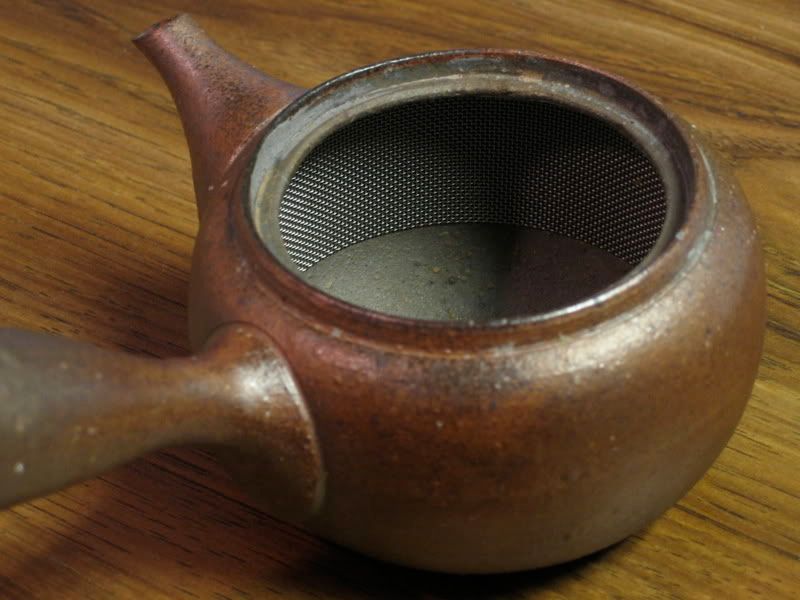
A very popular style of teapot in Japan is the kyūsu. The term "kyūsu" refers to the style of the teapot, which is characterized by its unique side handle.
 They tend to be small (see the size comparison to the right) and lightweight. This works well for Japanese green tea because it is typically prepared in small amounts, and the lightweight material allows for a perfect amount of heat retention. Too much heat retention could cook the leaves, while too little would just wick the heat away from your tea and could leave it lukewarm.
They tend to be small (see the size comparison to the right) and lightweight. This works well for Japanese green tea because it is typically prepared in small amounts, and the lightweight material allows for a perfect amount of heat retention. Too much heat retention could cook the leaves, while too little would just wick the heat away from your tea and could leave it lukewarm.Another feature of many kyūsu is the built-in filter. There are three main types: obi-ami (shown here), ita-ami, and sasame. Obi-ami steel mesh filters circle all the way around the interior of the teapot, and generally pour very well. Ita-ami filters are also made of a steel mesh, but only drape over the spout. For people who are very particular about keeping a metallic taste from influencing their tea (though I have never noticed this from the obi-ami), there is the sasame filter, which is made from the same clay as the rest of the pot and covers the entrance to the spout. The benefit of using any of these three filters, as opposed to an infuser basket, is that the tea leaves can fully expand and release their full potential.
 Japanese green tea leaves are very tightly rolled, so when they expand they can occupy quite a large volume.
Japanese green tea leaves are very tightly rolled, so when they expand they can occupy quite a large volume.The Tokoname region is well known for its stoneware, including their kyūsu. Tokoname kyūsu, such as the one shown here, are made from clay. They are similar in composition to the famous Yixing teapots from China, but modified to better suit the local clay (and tea). Like Yixing teaware, Tokoname stoneware (assuming it is unglazed) is porous. This means that over the course of many uses, the teapot absorbs some flavor into the pores in its surface, and can improve the flavor of tea brewed in it. Therefore, it is not recommended to brew vastly different types of tea in one unglazed kyūsu, to prevent contamination of flavors.

The teapot shown in previous pictures, the "Hiramaru" from Rishi Tea, is an example of a Tokoname kyūsu. The glaze used here is a natural ash glaze, which gives an interesting iridescent yet natural look. My other kyūsu, shown here, is from Artistic Nippon, another high quality Japanese teaware vendor. Now that I have a newer pot to compare the Hiramaru to, I can say that the Hiramaru is not perfect. It looks interesting, but the craftsmanship and functionality are nowhere near that of my new kyūsu from Artistic Nippon.
Suggested Tokoname Kyūsu vendors:
•Artistic Nippon
•O-Cha.com
•Hibiki-an
•Den's Tea
•Rishi Tea


Interesting post on Japanese teapots. Just leaving a post to show there are readers out there. Cheers.
ReplyDeleteI enjoyed the review of the hiramaru, thank you.
ReplyDeleteIn case you or anyone wanted a little more information on the sasame, here is part of an email I recieved from Sean O'leary of Rishi:
/#1: I just received a kikumaru kyusu today, and I love it. My wife and
I were curious if the sesame was hand maid or done buy a machine. It
looks so precise!/
I'm glad to hear you love the new teapot! The sasame clay mesh screens
are indeed machine made. I was lucky enough to visit the company that
invented this machine (I believe in the 70's) and it has been a closely
kept secret. They spent many years researching this screen, looking for
the perfect number/sizes of holes for optimal pouring function, as well
as the curvature of the mold for optimal strength. These sasame clay
screens are shipped to the artist (while they are still wet) who then
apply them to the teapots before drying and firing.
Thank you so much for the post, very informative about the different filter types.
ReplyDeleteNow, two questions:
is that teapot easy to clean?
and. Being made in clay, doesn't that affect the taste of the teas you brew? I mean, after brewing a kind of tea, I would think that the clay will absorb some of it's taste and release in the next brew.
Am I wrong? :)
Thanks